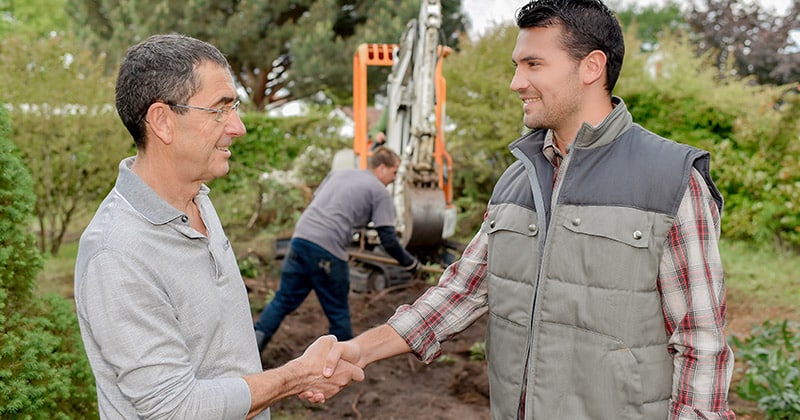How to Price Landscaping Jobs
Pricing a landscaping job demands confidence, creativity, and an eye for detail. It is crucial to create a smart pricing plan that reflects your passion yet addresses the costs.

Staff Contributor
Pricing a landscaping job demands confidence, creativity, and an eye for detail. It takes talent and a love of nature to sculpt the land. It also requires physical labor and practical tools.
For successful landscaping jobs, create a smart pricing plan that reflects your passion yet addresses the costs.
In this article, we’ll dig into the nitty-gritty of setting prices that will make your landscaping business bloom. We’ll explain three different types of pricing models. Then, cover the basic costs of landscaping jobs and how to calculate them job by job.
You’ll also learn how to price different types of landscaping jobs, such as landscape design, shrub pruning, and lawn mowing.
Then we’ll discuss how to keep your prices consistent, client-to-client and season-to-season. What are the pitfalls to avoid?
Finally, we’ll give you some tips to make your pricing more innovative and customer friendly. Let’s dig in.
Choosing Your Landscaping Services Pricing Model

View your pricing model as a blueprint that brings your landscape job to life. Like planning the design of a garden, your pricing model is a structured plan that outlines how much you’ll charge for your landscaping services. It’s where creativity meets strategy.
Your pricing model considers all the details, from the cost of materials and tools to the hours your team spends bringing your vision to life. And like a garden, your pricing model can grow and evolve with your business over time.
Here are three basic pricing models to consider.
Time and Materials Model
With this model, you charge clients based on the time your team spends on the landscaping job and the materials you use.
Pros: This model is transparent and lets your clients see exactly where their money is going. It’s flexible and suitable for projects where the ultimate vision might shift along the way. And if your client has customized requests, this model lets you account for them without much hassle.
Cons: The final cost might not be clear from the start. Unexpected challenges might pop up, creating extra expenditures and possible friction. Also, the more efficient your team gets, the less you might earn by charging by the hour.
The time and materials model can be a good choice for projects with many variables or when testing the waters with a new client.
The Fixed Price Model
The fixed price model sets a price for a specific landscaping job, regardless of the time or materials needed to finish it.
Pros: Your client knows exactly what to expect. The clear, upfront cost eliminates surprises. It builds trust and confidence between you and your client. This model is good for projects with defined scopes, ensuring you get paid a fair price for your creativity and labor.
Cons: If you hit a snag or your client asks for modifications, you might end up putting in more effort than planned. The fixed price model is ideal for well-defined tasks where you can confidently estimate the resources required. If you underestimate the costs, you will have to absorb them.
Contract Model
This is an agreement you make with your client for landscaping services over an extended period, often monthly or yearly. It could include regular maintenance, seasonal updates, or ongoing improvements.
Pros: This model provides a steady stream of income. Clients sign up for your landscaping expertise on an ongoing basis, giving you solid revenue. You build rewarding relationships and have time to watch your gardens grow.
Cons: A contract requires a high level of commitment. You’ll need to keep up with regular communication, stick to deadlines, and ensure you meet your client’s expectations.
How to Calculate Costs for Landscaping

Use a practical formula instead of basing your estimates only on personal experience. Calculating costs for a landscaping job can be broken down into three basic parts: equipment, supplies, and labor. On top of that, you need to consider overhead and markup.
Equipment Costs
Equipment costs involve the tools and machines you’ll use for your landscaping job, such as lawnmowers, trimmers, and leaf blowers. To figure out equipment costs for each job, you should:
- List all the equipment you’ll use
- Compute how much it costs to buy or rent each tool
- Estimate how long you’ll use each tool for the job
There should be an hourly rate for each piece of equipment you use. Include that charge in your estimate.
Supply Costs
Supply costs are all the materials you need for the landscaping job, like fertilizer, shrubs, gravel, lawn turf, wood chips, plants, and trees.
The National Association of Landscape Professionals reports that supply chain issues are less of a problem than they have been in previous years. Continuing inflation is still a concern, so consider current and future prices for materials in your estimate.
Labor Costs
Labor hours are the time it will take to complete the landscaping job multiplied by the number of people working. In addition to wages, include the cost of taxes, worker’s compensation, and benefits.
Overhead Costs
Overhead costs include office rent and salaries, vehicle expenses, advertising, uniforms, software, accounting services, insurance, and other general costs not tied to a specific project.
Add up your weekly overhead costs. Divide that amount by the average number of labor hours per week. Add that amount to the job cost based on the number of hours you think the job will take.
For example, your overhead costs are $1,000 per week. Your labor hours are 100. You will need to charge an extra $10 per labor hour to cover your overhead. If you estimate the job will take 10 hours, you must add $100 in addition to the cost of equipment, supplies, and labor.
Markup
Markup is not overhead. It is the amount you add on top of your actual expenses to make sure you are not only covering your costs but also making a profit. If you want to make a 25% profit on a job that will cost you $1,000 to complete, you need to add another $250 to the estimate. Otherwise, you will only break even.
Job-by-Job Pricing
Before you start your estimate, make sure that you and the potential client are on the same page. Ask questions. What kind of landscaping services are they interested in? Garden design? Regular lawn mowing? Seasonal maintenance? How much is their budget?
Visit the site yourself. Is it in a remote location? Figure in fuel costs. Walk around the property and measure it. Take photos. What are the tree and plant types? Count the shrubs that will need to be pruned. Picture what the property will look like under your care.
Estimate the costs for the tools and supplies you will need to complete the landscaping job, as well as the number of labor hours. List every task involved to complete the job so you do not underestimate the labor costs or the fees for using the equipment. Then be sure to add in your overhead and the markup for your profit to correctly price the job.
How to Price Different Kinds of Landscaping Jobs

Some landscaping jobs like lawn mowing or shrub pruning are straightforward and can be charged by the hour. You can also offer seasonal jobs like leaf blowing for a flat rate.
First, determine how much you need to make per hour for the service to be profitable. Then consider the details.
What size lawn are you mowing? Is it hilly or flat? What type of lawn mower are you using? A push mower or a riding mower?
How many shrubs need pruning? Are you using hand shears or pruning saws?
Are you raking up the shady leaves of a great oak tree? Remember the acorns.
After estimating how much labor the job will take, don’t forget to add the hourly fee for the use of the equipment, your overhead, and the markup.
Landscape Design
Jobs like landscape design range from simple solutions to complex projects. Adding a comfortable backyard seating area would cost less than redesigning an entire property. You should charge accordingly for your unique landscape design.
Founded in 1899, the American Society of Landscape Architects (ASLA) offers a variety of reasons to hire a landscape designer. When discussing landscape design pricing with clients, tell them why your services are a good investment. Designing an eye-catching landscape that improves a property is a distinct talent. It’s not just mowing the lawn.
Landscape designers can:
- Add as much as 15% to a home’s value
- Plan all the landscape design details, including materials, styles, and textures
- Create low-maintenance gardens with native plants
- Use proper tree placement to lower energy bills
- Develop rain gardens to attract birds and helpful insects
- Create natural swimming pools, adding an element of beauty to the property
- Devise irrigation systems to water plants at the root
On average, landscape designers charge between $50 and $150 per hour. According to Lawn Love, most people pay between $1,960 and $7,220 to hire a landscape designer—for the design only.
Here are some different methods to calculate charges for landscape design:
- Design rate: a set price for the complete design plan
- Hourly rate: an hourly rate for complex projects with many variables and revisions. Include the time for the initial consultation
- Project rate: a flat fee based on the size and estimated hours of the entire project. Limit the number of design revisions
- Percent rate: an additional 15 to 20% on top of the price of the project to include the design
How to Price and Quote Landscaping Jobs Consistently

Keeping your prices consistent can be a challenge. Different seasons need different strategies. What is in demand in the spring when gardens are blooming might not be needed in the fall.
While each client’s needs may vary, having a baseline for services keeps your pricing fair and competitive. It doesn’t matter whether you’re working on a small suburban yard or a sprawling estate. Clients will appreciate consistency and transparency in your pricing.
Consider these strategies for consistent pricing:
Map out your pricing structure.
List each individual landscaping service you offer, from mowing to mulching to tree trimming. Use this map as your baseline for setting prices.
Account for variables.
No two properties are the same. Set up a system to adjust your prices based on factors like yard size and client needs. Got a larger yard? Bump up the price a bit. Working with a rocky terrain? Add an adjustment.
Regularly review and adjust pricing.
Make sure you are up-to-date with current market trends. Prices that are too far above market value may make your business less attractive to new customers. Come in too low and you won’t make enough profit.
Use seasonal pricing.
Airlines and hotels change their pricing based on the demands of the season, and so should you. When it’s time to plant and prune, tweak up the price. During winter, adjust down. This keeps you profitable year-round.
Provide detailed quotes.
Break down your quote like you’re explaining a recipe. Labor, materials, equipment—lay it all out.
Offer package deals.
Put some “specials” on your menu. Bundle related services together at a fixed price, such as lawn mowing and weed control. Packages keep your pricing consistent while giving your clients a choice.
When it comes to setting prices for your landscaping jobs, there are a few things you should watch out for. Let’s look at some of the pitfalls so you can steer clear and keep your pricing on the right track.
Ignoring market trends
Not paying attention to what other landscaping companies are charging can lead to prices that are too high or low. Keep your eye on the market. Adjust for inflation.
Guessing at pricing
Never assume you know what future prices will be. Research and calculate every dime you’ll spend on labor, equipment and supplies. Don’t forget to factor in your overhead and markup as well.
One-size-fits-all approach
Each property has its own personality. Don’t make the mistake of treating them all the same. Have a baseline, but adjust it for each client’s quirks.
Forgetting to adjust for variables
Ignoring items like hilly terrain and property location can lead to disputes. Always be ready to adjust and tweak as needed.
Lack of transparency
Make sure your quotes and invoices are clear and easy to understand. Hidden fees or undisclosed costs can make customers feel misled and frustrated. An unhappy customer won’t return.
Jumbled pricing
While adding variables is smart, don’t over-complicate your pricing structure. Use one calculation for your overhead and markup pricing. Trying to adjust those charges per job or expense makes bookeeping overly complicated. Keep it simple, avoiding confusion for your team and your clients.
Improving Your Process to Price Landscaping Jobs

Create a fresh approach to pricing that captures the attention of clients. Offering innovative solutions to landscaping jobs can set your landscaping business apart. Here are some tips to improve your pricing process:
Eco-friendly pricing
Offer a reduced price for landscaping materials and practices that are environmentally friendly. This positions your business as a leader in sustainable landscaping.
Seasonal subscription plan
Offer clients subscription-based pricing where they pay a monthly fee for year-round maintenance. This gives you a predictable income and encourages clients to commit to ongoing services.
Pay-what-you-can pricing
Run a pay-what-you-can model for community projects or charities. This will showcase your commitment to giving back and earn your landscaping business a positive reputation.
Loyalty points system
Create a program where clients earn points for every service, redeemable for discounts or free services in the future. This encourages repeat business.
Price lock-in guarantee
Commit to keeping your rates consistent for a certain period, regardless of changes in the market. This builds client trust and loyalty.
Landscaping software
Streamline your business and manage operations. Keep track of start and end dates for each contract. Plan schedules for your crew.
Lisa loves words—particularly how they have the potential to transform lives when shared with positive intent. When she’s not connecting the dots for writing projects, she is outside enjoying everything nature says with no words.

Business Solutions For Field Service Pros
EverPro offers specialized solutions designed for home and field service professionals. We’ve got the business tools to help you get the job done.



